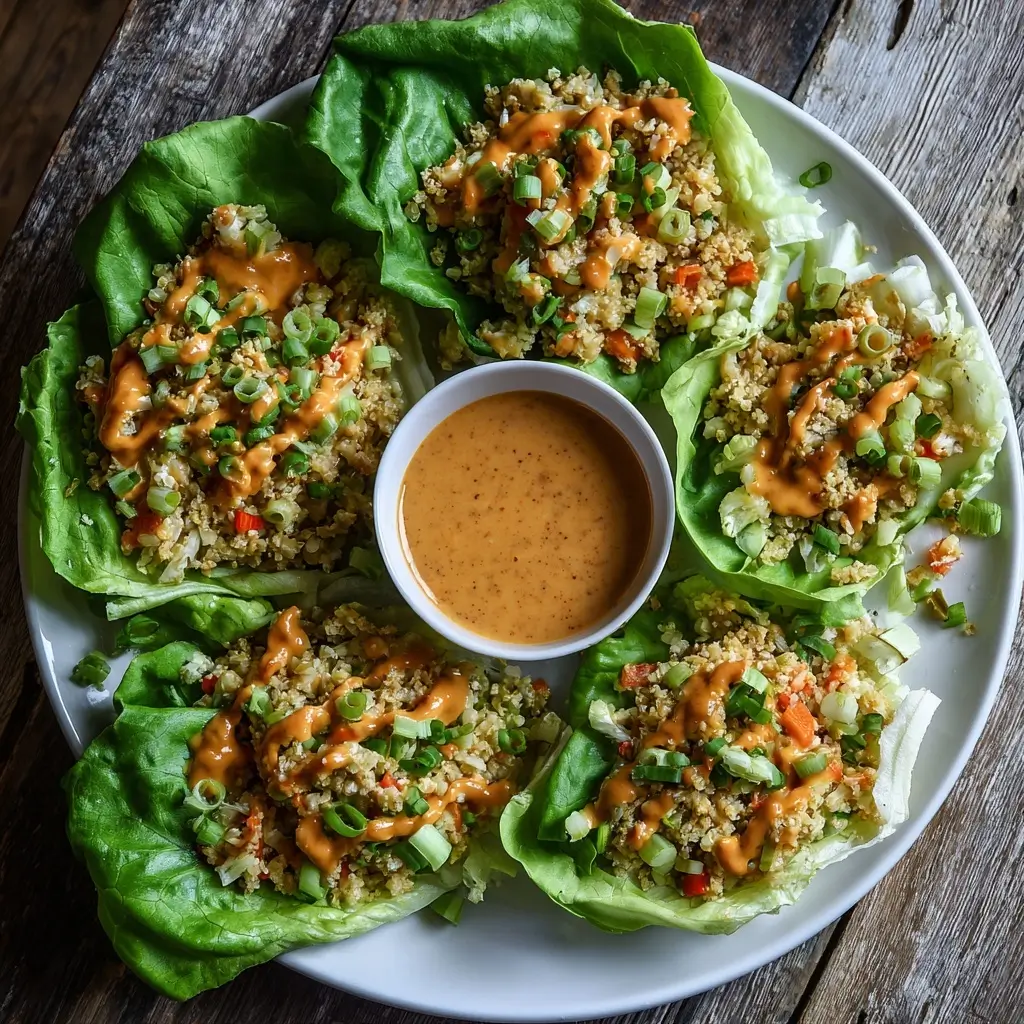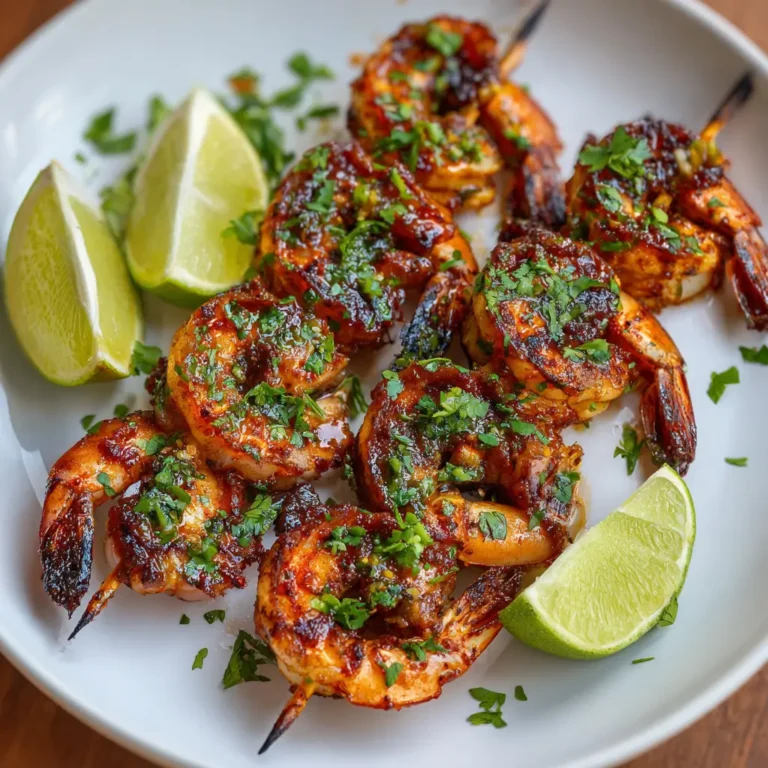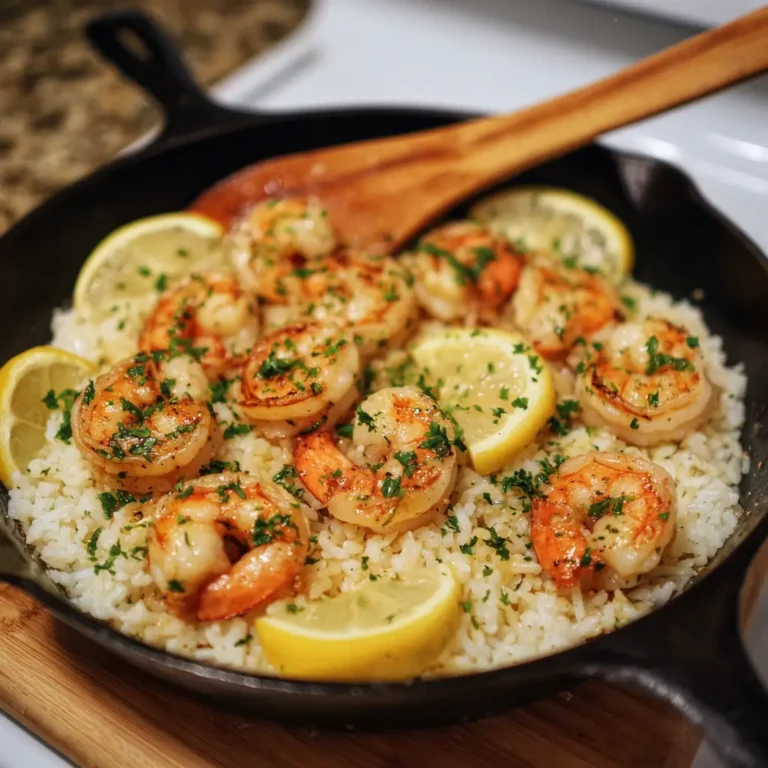Cauliflower Rice Lettuce Cups with Sriracha Peanut Sauce
Introduction
Welcome to a vibrant, health-conscious culinary adventure with our Cauliflower Rice Lettuce Cups with Sriracha Peanut Sauce. These delightful little bundles are the perfect fusion of bold Asian-inspired flavors and clean, wholesome ingredients. Whether you’re on a low-carb journey, embracing a plant-based lifestyle, or simply seeking a quick, nutritious meal, these lettuce cups offer a refreshing alternative to traditional rice bowls and tacos. Light yet satisfying, colorful and packed with umami richness, they’re ideal for weeknight dinners, lunch prep, or even as an elegant appetizer at your next gathering. With their crisp lettuce shells, fluffy cauliflower rice filling, and a luscious drizzle of spicy-sweet peanut sauce, every bite is a celebration of texture and taste.
The History
The concept of lettuce wraps has deep roots in various global cuisines, particularly in Southeast Asian and Chinese cooking traditions. In countries like Thailand, Vietnam, and China, fresh vegetables—especially lettuce—are commonly used as edible wrappers for seasoned meats, herbs, and rice. This practice not only adds a refreshing crunch but also reduces reliance on breads and grains, making meals lighter and more digestible. Over time, Western adaptations began incorporating these ideas into health-focused diets, especially during the rise of low-carb, keto, and paleo lifestyles in the early 2010s. Cauliflower rice emerged as a revolutionary substitute for traditional rice, offering similar texture with far fewer calories and carbohydrates. Meanwhile, peanut sauces have long been a staple in Thai and Indonesian cuisine, where ground peanuts are blended with chili, garlic, lime, and fish sauce to create rich, balanced dressings. Combining all these elements—the ancient wisdom of vegetable wrapping, the modern innovation of riced cauliflower, and the bold flavor profile of Southeast Asian condiments—we arrive at the contemporary dish of Cauliflower Rice Lettuce Cups with Sriracha Peanut Sauce: a globally inspired, nutritionally optimized creation that honors tradition while embracing dietary evolution.
Ingredients Breakdown
Every component of this recipe has been thoughtfully selected to deliver maximum flavor, texture, and nutritional value. Here’s a detailed look at what goes into making these delicious lettuce cups:
- Cauliflower: The star of the dish, riced into tiny florets that mimic cooked rice when sautéed. Low in calories and high in fiber and antioxidants like vitamin C and glucosinolates, it’s a powerhouse vegetable base.
- Lettuce (Butter, Romaine, or Iceberg): Used as natural, biodegradable “cups,” these leafy greens provide a crisp contrast to the warm filling. They’re hydrating, low-calorie, and add a refreshing coolness.
- Soy Sauce or Tamari: Adds savory umami depth. Opt for gluten-free tamari if needed. Rich in amino acids and fermented goodness, it enhances overall flavor complexity.
- Garlic & Ginger: Freshly minced for aromatic heat and anti-inflammatory benefits. Both are known for immune-boosting properties and digestive support.
- Carrots and Bell Peppers: Finely diced for color, sweetness, and added crunch. Packed with beta-carotene, vitamin A, and antioxidants, they contribute both nutrition and visual appeal.
- Green Onions: Provide a mild onion kick and bright pop of green. Also rich in flavonoids and vitamin K.
- Sesame Oil: A small amount imparts a nutty aroma and helps carry flavors. Use toasted sesame oil for deeper flavor.
- Scallions and Cilantro: Fresh herbs that elevate freshness and add herbal brightness, commonly found in Asian cuisine.
- Sriracha Peanut Sauce: The crowning glory, combining creamy peanut butter, spicy sriracha, tangy lime juice, soy sauce, maple syrup, garlic, ginger, and water for consistency. It balances sweet, spicy, sour, salty, and umami notes perfectly.
- Optional Protein Add-ins: Tofu, chicken, shrimp, or edamame can be incorporated for extra satiety and protein content.
This harmonious blend ensures each ingredient plays a role—not just in taste, but in nourishment and sensory delight.
Step-by-Step Recipe
- Prepare the Cauliflower Rice: Remove leaves from one head of cauliflower and break it into florets. Pulse in a food processor until it resembles coarse grains of rice (avoid over-processing). Alternatively, use pre-riced cauliflower from the store for convenience.
- Sauté the Aromatics: Heat 1 tablespoon of avocado oil or coconut oil in a large skillet over medium heat. Add 2 minced garlic cloves and 1 tablespoon grated fresh ginger. Sauté for about 30 seconds until fragrant—do not burn.
- Cook the Cauliflower: Add the riced cauliflower to the skillet. Stir-fry for 6–8 minutes until tender but still slightly firm (al dente). Avoid covering the pan to prevent excess moisture buildup.
- Add Vegetables: Stir in ½ cup finely diced carrots, ½ cup diced red bell pepper, and 2 thinly sliced green onions. Cook for another 3–4 minutes until vegetables soften slightly.
- Season the Mixture: Pour in 2 tablespoons soy sauce (or tamari), 1 teaspoon sesame oil, and a pinch of black pepper. Mix well and cook for 1 minute more. Taste and adjust seasoning as desired. Remove from heat and set aside.
- Make the Sriracha Peanut Sauce: In a small bowl, whisk together ¼ cup smooth natural peanut butter, 1–2 tablespoons sriracha (adjust to spice preference), 2 tablespoons fresh lime juice, 1 tablespoon soy sauce, 1 tablespoon maple syrup or honey, 1 clove minced garlic, ½ teaspoon grated ginger, and 2–3 tablespoons warm water to thin the sauce to a drizzling consistency.
- Prep the Lettuce Cups: Gently separate large outer leaves from a head of butter lettuce, romaine hearts, or iceberg. Rinse and pat dry. Lay them out on a serving platter, cup side up.
- Assemble the Lettuce Cups: Spoon the warm cauliflower rice mixture evenly into each lettuce cup. Drizzle generously with the homemade Sriracha Peanut Sauce.
- Garnish and Serve: Top with chopped cilantro, additional green onions, crushed peanuts, sesame seeds, or a squeeze of extra lime juice. Serve immediately while flavors are vibrant.
Tips
- Avoid Mushy Cauliflower Rice: Don’t overcrowd the pan or cover it while cooking. Excess steam makes the “rice” soggy. For best results, spread it out and let it sear slightly.
- Dry Your Lettuce Thoroughly: Wet lettuce will make the cups soggy and cause them to tear easily. Pat each leaf dry with a paper towel before assembling.
- Brighten the Flavor: Always finish with a squeeze of fresh lime juice just before serving—it lifts all the other flavors and prevents the dish from tasting flat.
- Batch Cooking Friendly: You can cook the cauliflower rice and prepare the sauce up to 3 days ahead. Store separately in airtight containers in the fridge and reheat the rice gently before assembling.
- Customize Heat Level: Adjust the amount of sriracha in the sauce based on your tolerance. You can also swap in gochujang for a Korean twist or chili garlic sauce for a different kind of heat.
- Use High-Quality Peanut Butter: Choose natural peanut butter without added sugars or hydrogenated oils for the best flavor and health benefits. Almond butter works as a tasty alternative for variety or allergies.
- Boost Texture: Add shredded cabbage, julienned cucumber, or mango for extra crunch and sweetness.
- Serve Warm or Cold: These cups can be enjoyed warm straight off the stove or chilled as a salad-style wrap—perfect for meal prep lunches.
Variations and Customizations
The beauty of this dish lies in its versatility. Once you master the base recipe, you can transform it into countless variations to suit your mood, dietary needs, or cultural inspirations:
- Vegan Version: Already naturally vegan if you use maple syrup instead of honey in the sauce. Ensure your soy sauce is vegan-friendly (some contain trace fish derivatives).
- Gluten-Free Option: Use certified gluten-free tamari instead of soy sauce and verify that your sriracha and peanut butter are GF-safe.
- Protein-Packed Editions: Stir grilled teriyaki tofu, sautéed shrimp, shredded chicken, or seasoned ground turkey into the cauliflower rice. Marinate proteins in soy sauce, garlic, and ginger beforehand for enhanced flavor.
- Mediterranean Twist: Swap peanut sauce for tahini-lemon dressing and mix in olives, cherry tomatoes, cucumber, and oregano. Use romaine cups for a gyro-style experience.
- Thai-Inspired: Add red curry paste to the cauliflower mix, toss in fresh basil and mint, and top with crushed peanuts and a splash of fish sauce in the dressing.
- Korean BBQ Style: Replace the peanut sauce with a gochujang-based glaze and add kimchi and marinated bulgogi beef or mushrooms.
- Low-Fat Adaptation: Reduce or omit oil when cooking cauliflower by using a non-stick pan and adding a splash of vegetable broth to prevent sticking.
- Kid-Friendly Version: Omit the sriracha or reduce it significantly. Add a touch more maple syrup to the sauce for sweetness kids love. Include finely diced apples or raisins for fun texture and natural sugar.
- Grain Bowl Alternative: Skip the lettuce and serve the cauliflower rice and toppings in a bowl. Add quinoa or brown rice for a heartier meal.
Health Considerations and Nutritional Value
These Cauliflower Rice Lettuce Cups with Sriracha Peanut Sauce are designed with wellness in mind, offering a nutrient-dense profile that supports various health goals:
- Low-Carb & Keto-Compatible: With only ~5–7g net carbs per serving, this dish fits seamlessly into ketogenic or diabetic meal plans, helping maintain stable blood sugar levels.
- High in Fiber: Thanks to cauliflower, vegetables, and optional legumes, each serving provides around 4–6g of dietary fiber, promoting gut health and satiety.
- Rich in Antioxidants: Cruciferous cauliflower contains sulforaphane, linked to cancer prevention. Carrots supply beta-carotene for eye health, while bell peppers offer vitamin C.
- Healthy Fats: The peanut sauce delivers monounsaturated fats from peanut butter and omega-3s if using flax-infused varieties, supporting heart and brain health.
- Plant-Based Protein Source: Natural peanut butter contributes ~7g of protein per 2 tablespoons. Adding tofu or edamame boosts this further, making it suitable for vegetarian and vegan diets.
- Anti-Inflammatory Benefits: Garlic, ginger, turmeric (optional addition), and sesame oil all possess anti-inflammatory compounds that may help reduce chronic disease risk.
- Sodium Awareness: Soy sauce is high in sodium; consider reduced-sodium versions or coconut aminos for a lower-salt option, especially beneficial for those managing hypertension.
- Allergen Notes: Contains peanuts—substitute sunflower seed butter or tahini for nut-free alternatives. Always check labels for cross-contamination if serving individuals with severe allergies.
Nutrition estimate per serving (2 lettuce cups with filling and sauce):
Calories: ~220 | Fat: 15g (mostly unsaturated) | Carbohydrates: 16g | Fiber: 5g | Sugar: 8g (natural from fruits and maple syrup) | Protein: 8g | Sodium: ~600mg (varies by soy sauce choice)
Ingredients
For the Cauliflower Rice Filling:
- 1 medium head cauliflower, riced (about 4–5 cups)
- 1 tbsp avocado oil or coconut oil
- 2 cloves garlic, minced
- 1 tbsp fresh ginger, grated
- ½ cup carrots, finely diced
- ½ cup red bell pepper, diced
- 2 green onions, sliced (plus extra for garnish)
- 2 tbsp soy sauce or tamari (gluten-free if needed)
- 1 tsp toasted sesame oil
- Pinch of black pepper
- Optional: 1 cup cooked tofu, shredded chicken, or edamame
For the Sriracha Peanut Sauce:
- ¼ cup natural smooth peanut butter
- 1–2 tbsp sriracha (to taste)
- 2 tbsp fresh lime juice
- 1 tbsp soy sauce or tamari
- 1 tbsp maple syrup or honey
- 1 clove garlic, minced
- ½ tsp fresh ginger, grated
- 2–3 tbsp warm water (to reach desired consistency)
For Assembly:
- 1 head butter lettuce, romaine, or iceberg (leaves separated)
- Fresh cilantro, chopped
- Crushed roasted peanuts
- Sesame seeds
- Lime wedges, for serving
Directions
- In a large skillet over medium heat, warm the avocado oil. Add garlic and ginger; sauté for 30 seconds until aromatic.
- Add the riced cauliflower and stir to combine. Cook for 6–8 minutes, stirring occasionally, until tender but not mushy.
- Stir in diced carrots, bell pepper, and green onions. Cook for 3–4 minutes more until vegetables begin to soften.
- Pour in soy sauce, sesame oil, and black pepper. Mix well and cook for 1 additional minute. If using pre-cooked protein (tofu, chicken, etc.), add now and heat through. Remove from heat and keep warm.
- While the rice cooks, prepare the Sriracha Peanut Sauce: In a bowl, whisk together peanut butter, sriracha, lime juice, soy sauce, maple syrup, garlic, ginger, and warm water until smooth and creamy. Adjust thickness with more water if needed. Set aside.
- Prepare lettuce leaves by washing and drying thoroughly. Arrange on a serving plate.
- Spoon the cauliflower mixture evenly into each lettuce cup.
- Drizzle generously with Sriracha Peanut Sauce.
- Garnish with chopped cilantro, crushed peanuts, sesame seeds, and extra green onions.
- Serve immediately with lime wedges on the side for squeezing over the top. Enjoy warm or chilled!
FAQ
Can I make this recipe ahead of time?
Yes! Prepare the cauliflower rice and sauce up to 3 days in advance. Store them separately in airtight containers in the refrigerator. Assemble just before eating to keep the lettuce crisp.
Is this recipe suitable for weight loss?
Absolutely. With balanced macronutrients, high fiber, and moderate healthy fats, this dish promotes fullness without excess calories—ideal for mindful eating and portion control.
Can I freeze the leftovers?
The cauliflower rice can be frozen for up to 2 months, though texture may become softer upon reheating. The sauce freezes well too. However, assembled lettuce cups should not be frozen.
What can I use instead of peanut butter?
Try almond butter, cashew butter, sunflower seed butter (great for schools with nut bans), or tahini for a sesame-based twist.
Why is my cauliflower rice watery?
This usually happens if the pan is covered or if the cauliflower wasn’t pulsed properly. Always cook uncovered and avoid steaming. Pre-salting and draining raw riced cauliflower can also help remove excess moisture.
Are there any nut-free options?
Yes! Use sunflower seed butter or tahini in place of peanut butter, and ensure all other ingredients are processed in nut-free facilities if allergies are a concern.
Can I bake the cauliflower rice instead of sautéing?
Definitely. Spread riced cauliflower on a baking sheet, drizzle with oil and seasonings, and roast at 425°F (220°C) for 20–25 minutes, stirring halfway, until golden and tender.
How do I pick the best lettuce for cups?
Look for large, sturdy outer leaves with a natural bowl shape. Butter lettuce is tender and sweet; romaine offers crunch; iceberg holds structure well. Avoid wilted or torn leaves.
Summary
Cauliflower Rice Lettuce Cups with Sriracha Peanut Sauce are a flavor-packed, nutrient-rich meal that combines the freshness of crisp lettuce with a savory, spiced cauliflower filling and a creamy, zesty peanut sauce. Perfect for meal prep, clean eating, or impressing guests, this dish proves healthy food can be incredibly delicious.






